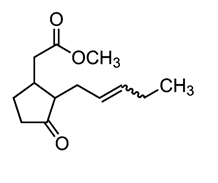Methyl jasmonate (MeJA), the derivative of Jasmonic acid (JA), has been found to occur naturally in a wide range of higher plants. JA and MeJA are volatile fatty compounds, derived from the family of octadecanoic fatty acids, and synthesized from linolenic acid membrane of chloroplast. MeJA has been considered as an elicitor or signaling agent involved in many physiological and biochemical processes and widely used in the field of postharvest preservation of fruits and vegetables. According to the recent reports, major positive effects of MeJA are inducing the resistance of fruits against fungal pathogens; inducing the resistance of fruits to low temperature stress; keeping the quality of harvested fruits (Tian and Zhang, 2016).
    |
 |
| Figure 1. Chemical structure of methyl jasmonate |
MeJA can act as a signal for inducing defence responses against pathogens in plant tissues. It has been reported that fungal pathogen infection causes oxidative stress by inducing the generation and accumulation of ROS in plants, such as H2O2 and O2. ROS leads to oxidative damages by oxidizing nucleic acids, proteins, lipids, or carbohydrates, affecting the integrity of cell membranes and inactivating key cellular functions. Therefore, activation of antioxidant strategies is necessary for the maintenance of cell redox homeostasis. The mechanisms involved in the MeJA-induced disease resistance are enhancing antioxidant capacities by increasing activities of peroxidase, catalase, ascorbate peroxidase, which is benefi cial for scavenging excess ROS and alleviating oxidative damage of proteins (Tian and Zhang, 2016). Another mechanism involved in the MeJA-induced disease resistance might be the expression of pathogenesis-related (PR) proteins. Jin et al. ( 2009 ) reported that MeJA was effective in reducing decay and might enhance disease resistance in peach fruit by increasing activities of PR proteins, including chitinase, β-1,3-glucanase.
MeJA enhances resistance of fruits to low temperature stress to alleviate chilling injury. Increasing evidence suggests that the cell membrane is the primary site for chilling stress. The chilling tolerance has been proved to be related to fatty acid composition in membrane lipids. Cao et al. (2009) found that MeJA treatment alleviated CI in loquat fruit by reducing lipoxygenase (LOX) activity and maintaining high unsaturated/saturated fatty acid ratio. They suggested that the increase of membrane unsaturation degree may be involved in the induction of resistance towards chilling stresses by MeJA.
MeJA, as a plant growth regulator, also affects fruit quality, which includes texture, color, flavor, aroma, and antioxidant properties. The external application of MeJA showed multiple effects on physiological processes, affecting the postharvest quality of fruit. However, the effect of MeJA has been in controversy. The exposure of mango cv. Tommy Atkins fruit to 10-4 M MeJA vapour did not change the normal climacteric rise in respiration, water loss, and softening rates of fruits. A lesser change in colour was observed in MeJA-treated fruits than control fruits (Gonzalez-Aguilar et al., 2000). Adversely, the use of 10-5 M MeJA enhanced yellow and red colour development in mango cv. Kent (González‐Aguilar et al., 2001). Fan et al. (2016) found that dipping in 5 µM MeJA reduced ethylene production, thus retarded the senescence and maintained fruit quality during storage in eggplant fruit. It was indicated that the delayed senescence in eggplant fruit by MeJA is related with enhancement of the antioxidant system.
Therefore, MeJA plays a versatile role in the field of postharvest preservation. Using MeJA alone or combined with biocontrol agents can effectively reduce the loss caused by pathogen infection. Considerable progress has been made in understanding the function of MeJA, as a promising technique to control postharvest diseases and to maintain fruit quality.
References
Tian S. & Zhang Z. (2016). Methyl Jasmonate. In: Postharvest Management Approaches for Maintaining Quality of Fresh Produce. Siddiqui, M. W., Ayala Zavala, J. F. & Hwang, C.-a. A. (eds.). Springer Switzerland: 97-111 pages.
Fan L., Shi J., Zuo J., Gao L., Lv J. & Wang Q. (2016). Methyl jasmonate delays postharvest ripening and senescence in the non-climacteric eggplant ( Solanum melongena L.) fruit. Postharvest biology and technology. 120: 76-83.
Gonzalez-Aguilar G., Fortiz J., Cruz R., Baez R. & Wang C. (2000). Methyl jasmonate reduces chilling injury and maintains postharvest quality of mango fruit. Journal of agricultural and food chemistry. 48(2): 515-519.
González‐Aguilar G. A., Buta J. G. & Wang C. Y. (2001). Methyl jasmonate reduces chilling injury symptoms and enhances colour development of ‘Kent’mangoes. Journal of the Science of Food and Agriculture. 81(13): 1244-1249.
Jin P., Zheng Y., Tang S., Rui H. & Wang C. Y. (2009). Enhancing disease resistance in peach fruit with methyl jasmonate. Journal of the Science of Food and Agriculture. 89(5): 802-808.
Cao, S., Zheng, Y., Wang, K., Jin, P., & Rui, H. (2009). Methyl jasmonate reduces chilling injury and enhances antioxidant enzyme activity in postharvest loquat fruit. Food Chemistry, 115, 1458–1463.
Hanh Nguyen
Department of Postharvest Technology, Faculty of Food Science and Technology